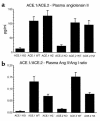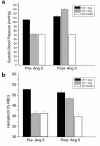Lack of angiotensin II-facilitated erythropoiesis causes anemia in angiotensin-converting enzyme-deficient mice
- PMID: 11104792
- PMCID: PMC381466
- DOI: 10.1172/JCI10557
Lack of angiotensin II-facilitated erythropoiesis causes anemia in angiotensin-converting enzyme-deficient mice
Abstract
While nephrologists often observe reduced hematocrit associated with inhibitors of angiotensin-converting enzyme (ACE), the basis for this effect is not well understood. We now report that two strains of ACE knockout mice have a normocytic anemia associated with elevated plasma erythropoietin levels. (51)Cr labeling of red cells showed that the knockout mice have a normal total blood volume but a reduced red cell mass. ACE knockout mice, which lack tissue ACE, are anemic despite having normal renal function. These mice have increased plasma levels of the peptide acetyl-SDKP, a possible stem cell suppressor. However, they also show low plasma levels of angiotensin II. Infusion of angiotensin II for 2 weeks increased hematocrit to near normal levels. These data suggest that angiotensin II facilitates erythropoiesis, a conclusion with implications for the management of chronically ill patients on inhibitors of the renin-angiotensin system.
Figures







Similar articles
-
The use of knockout mouse technology to achieve tissue selective expression of angiotensin converting enzyme.J Mol Cell Cardiol. 2004 Jun;36(6):781-9. doi: 10.1016/j.yjmcc.2004.02.013. J Mol Cell Cardiol. 2004. PMID: 15158118 Review.
-
Micropuncture determination of nephron function in mice without tissue angiotensin-converting enzyme.Am J Physiol Renal Physiol. 2005 Mar;288(3):F445-52. doi: 10.1152/ajprenal.00297.2004. Epub 2004 Oct 19. Am J Physiol Renal Physiol. 2005. PMID: 15494545
-
Role of angiotensin-converting enzyme (ACE and ACE2) imbalance on tourniquet-induced remote kidney injury in a mouse hindlimb ischemia-reperfusion model.Peptides. 2012 Jul;36(1):60-70. doi: 10.1016/j.peptides.2012.04.024. Epub 2012 May 8. Peptides. 2012. PMID: 22580272
-
Participation of the renin-angiotensin system in the captopril-induced worsening of anemia in chronic hemodialysis patients.Clin Nephrol. 1986 Jul;26(1):27-32. Clin Nephrol. 1986. PMID: 3524928
-
Circulating versus local angiotensin II in blood pressure control: lessons from tissue-specific expression of angiotensin-converting enzyme (ACE).Crit Rev Eukaryot Gene Expr. 2004;14(1-2):137-45. Crit Rev Eukaryot Gene Expr. 2004. PMID: 15104531 Review.
Cited by
-
Effect of angiotensin II on cord blood CD34+ cells expansion in vitro.J Huazhong Univ Sci Technolog Med Sci. 2005;25(1):26-8. doi: 10.1007/BF02831378. J Huazhong Univ Sci Technolog Med Sci. 2005. PMID: 15934300
-
Prognostic Impact of the Ratio of Hemoglobin to Red Blood Cell Distribution Width in Patients after Acute Decompensated Heart Failure.Intern Med. 2025 Mar 15;64(6):807-816. doi: 10.2169/internalmedicine.3691-24. Epub 2024 Aug 10. Intern Med. 2025. PMID: 39135256 Free PMC article.
-
Inhibition of fibroblast growth factor 23 (FGF23) signaling rescues renal anemia.FASEB J. 2018 Jul;32(7):3752-3764. doi: 10.1096/fj.201700667R. Epub 2018 Feb 26. FASEB J. 2018. PMID: 29481308 Free PMC article.
-
Genetic Variations Related to Angiotensin II Production and Risk for Basal Cell Carcinoma.Biochem Genet. 2025 Apr;63(2):917-935. doi: 10.1007/s10528-024-10746-0. Epub 2024 Mar 28. Biochem Genet. 2025. PMID: 38546913 Review.
-
Contributions of leukocyte angiotensin-converting enzyme to development of atherosclerosis.Arterioscler Thromb Vasc Biol. 2013 Sep;33(9):2075-80. doi: 10.1161/ATVBAHA.113.301777. Epub 2013 Jul 11. Arterioscler Thromb Vasc Biol. 2013. PMID: 23846498 Free PMC article.
References
-
- Vlahakos DV, et al. Association between activation of the renin-angiotensin system and secondary erythrocytosis in patients with chronic obstructive pulmonary disease. Am J Med. 1999;106:158–164. - PubMed
-
- Jensen JD, Eiskjaer H, Bagger JP, Pedersen EB. Elevated serum level of erythropoietin in congestive heart failure related to renal function. J Intern Med. 1993;233:125–130. - PubMed
-
- Julian BA, et al. Erythropoiesis after withdrawal of enalapril in post-transplant erythrocytosis. Kidney Int. 1994;46:1397–1403. - PubMed
-
- Macdougall IC. The role of ACE inhibitors and angiotensin II receptor blockers in the response to epoetin. Nephrol Dial Transplant. 1999;14:1836–1841. - PubMed
-
- Cruz DN, Perazella MA, Abu-Alfa AK, Mahnensmith RL. Angiotensin-converting enzyme inhibitor therapy in chronic hemodialysis patients: any evidence of erythropoietin resistance? Am J Kidney Dis. 1996;28:535–540. - PubMed
Publication types
MeSH terms
Substances
LinkOut - more resources
Full Text Sources
Medical
Molecular Biology Databases
Miscellaneous

